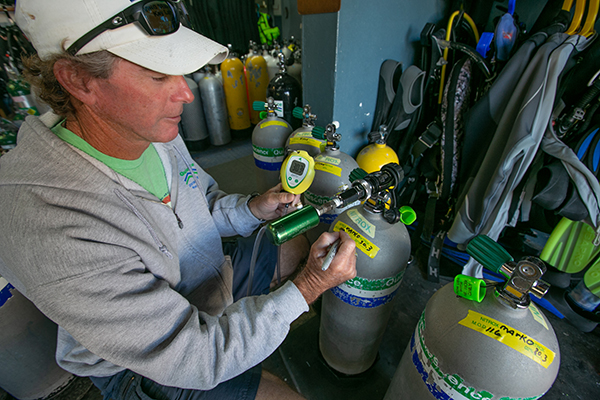BREATHING GAS
QUALITY ASSURANCE

ENSURING SAFE BREATHING GAS and establishing what to do in the event of contamination (or suspected contamination) are essential actions that must be considered by all who operate gas filling stations.
Whether you fill cylinders for your own business or others — or have cylinders filled for your clients — it is important to take note of the quality assurance measures covered in this article. No matter how or where your cylinders are filled, you are responsible for providing your clients with safe breathing gas.BREATHING FAS
HOW OFTEN SHOULD I
HAVE MY AIR QUALITY TESTED?
Testing frequency is not really established by U.S. regulations, but some dive certification agencies and other countries do provide requirements.
We should keep in mind that any air quality test is taken on a particular day at a particular time; this does not guarantee that the air will not become contaminated a few months, days, or even minutes later.
A test is thus only one of many important actions to consider in ensuring safe gas. How often you test therefore depends on an assessment of relevant contamination hazards near your facility.
DO CONTAMINANT LIMITS
ACTUALLY MEAN SOMETHING?
In most cases we rely on safety, research, and regulatory organizations to determine acceptable contamination limits. Not much work has been done to understand how contaminants such as CO, CO2, and particulate matter affect breathing gases for scuba diving. DAN has assessed limits with regard to the three primary types of hazards that these contaminants may present to scuba divers: fire, mechanical, and physiological.
WHAT SHOULD I BE DOING?
There are certain preventative steps dive operators can take to ensure quality breathing gas. Proper compressor maintenance, monitoring filter effectiveness, controlling the air intake location, inspecting cylinders, and clean handling during cylinder maintenance are some of the actions you can take.
Monitoring your actual air quality test reports to see whether there are any patterns in rising contaminant levels or instances in which the limits were approached will provide additional early warnings. The atmospheric value of CO2 today is around 420 ppm. Depending on your recent test results this may lead you to ask yourself why a test result may be higher than that, even if it meets the specification. This could help you in tracking variables, such as a new compressor intake position, for example, or a restaurant that opened next door with an extractor fan near your facility.
Good record-keeping of all your actions to ensure clean gas will not only provide you with better information but also better validation if something were to happen and you were held accountable in some way.
RESPONDING TO
CONTAMINATION
Sometimes accidents happen despite our best efforts to prevent them, and sometimes they happen because of a lack of discipline — or even negligence. In the moment it doesn’t really matter what the cause was; it is essential to know how to react once you find out (or even suspect) that gas may be contaminated.
You need an effective and appropriate emergency plan that details who to notify, what steps to take to assist any injured diver, how to prevent further contamination injuries, and how to prepare for any subsequent investigations or actions.
Never attempt to hide any of your actions — doing so could result in repeated incidents or lead to serious legal trouble.
DAN Customer Service
Mon–Fri, 8:30 a.m. – 5 p.m. ET
+1 (919) 684-2948
+1 (800) 446-2671
Fax: +1 (919) 490-6630
24/7 Emergency Hotline
In event of a dive accident or injury, call local EMS first, then call DAN.
24/7 Emergency Hotline:
+1 (919) 684-9111
(Collect calls accepted)
DAN must arrange transportation for covered emergency medical evacuation fees to be paid.
Medical Information Line
Get answers to your nonemergency health and diving questions.
Mon–Fri, 8:30 a.m. – 5 p.m. ET
+1 (919) 684-2948, Option 4
Online: Ask A Medic
(Allow 24-48 hours for a response.)

